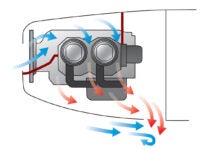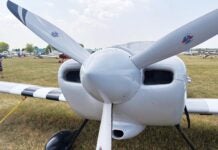Figure 1: Mike Rettig’s RV-10 aft fuselage section uses aluminum panels and stiffeners for primary structure. (Photo: Mike Rettig)
You might have noticed that most airplanes have some sort of exterior surface, perhaps fabric or something more rigid like aluminum or composite. Structurally, it can make sense to make the outer surface rigid, since that can provide the maximum possible rigidity. Plus the surface generally has to be there anyway, so it might as well be useful. If it’s properly done and carries load, then it can even save weight, compared to an internal skeleton.
Panels can buckle when loaded in compression or shear, and that’s a major issue. The panels are generally thin, and thin panels can’t carry as much load, obviously, as thick panels. Less obvious is the fact that their overall dimensions affect the buckling load just as much as the thickness does. That’s one of the reasons why we often have stiffeners attached; they divide a single large panel into smaller ones. If done right they also carry some load themselves and that further helps. We’ll look at stiffeners in another article. Here, we’re looking at the panels themselves. We’re assuming that the panels are flat. Often there’s actually a slight curvature and we should ignore the minor additional buckling resistance the curvature provides. If the curve is significant, though, we ought to take advantage of the curve, because it’ll stiffen the panel. If the curve is in the direction of the compression load, so that the panel is being loaded out of plane, the techniques described here aren’t applicable.
Figure 2: Parameters for buckling in compression. Generally speaking, curve C is usually applicable.
Panels start to buckle at a stress that we can calculate, fortunately. Here’s the equation for this for panels loaded in compression:
Equation 1: fc = (π2 * Kc * E) / (12 * (1 – ν2)) * ( t / b)2
Where
fc = compressive stress that will buckle the panel, psi
Kc = a constant we’ll pull off Figure 2
E = our old friend, the modulus of elasticity, psi
t = the thickness of the panel, inches
b = the short dimension of the panel, inches
ν = Poisson’s ratio, a material property
The equation for the buckling stress of a panel in shear is almost exactly the same. The only differences are that it uses a constant from a different graph:
Equation 2: fs = (π2 * Ks * E) / (12 * (1 – ν2)) * ( t / b)2
Where
fs = the shear stress that will buckle the panel, psi
Ks = a shear constant we’ll find on Figure 3
There might even be some in-plane bending. If there is, that also uses a form of the same basic equation:
Equation 3: fb = (π2 * Kb * E) / (12 * (1 – ν2)) * ( t / b)2
Where
fb = the bending stress that will buckle the panel, psi
Kb = a constant we’ll get from Figure 4
Figure 4 shows curves that are a bit more complicated than the other graphs. The first thing to note is that the curves are wavy. You can see a little bit of that in Figures 2 and 3, too. This is because the proportions of the panel matter a lot in bending, and this gives you a way to tweak the strength at relatively low cost. If you can get a length/width ratio that falls near a peak on the curve, the panel will buckle at a higher stress than if it falls in a trough.
Another aspect of the curves is that there are a lot of them, and they seem to depend on a mysterious factor called β. β is a number that is used to assess the amount of the panel that’s in compression. Normally, of course, symmetric panels or beams in pure bending have a neutral axis halfway across their height. If there’s a compression stress applied to the panel in addition to the bending, then there’s more of the panel that’s in compression and β allows for that. If there’s no compression,
β = 2. If there were some compression, we’d have to draw it out, making a little sketch to scale and assess β as necessary.
As you might have guessed by now, it’s not quite as simple as it seemed. But it almost is.
First, we have the usual three types of edge fixity. Since the panels are rectangular, they have four sides. Each side can either be fixed, simply-supported or free. It’s difficult to put loads or reactions into a free edge, so generally those would be on the unloaded sides, if any are free at all. Most aircraft panels aren’t. The panels are either simply supported or fixed. “Clamped” is another word used to describe a fixed edge.
Simply supported means that the edge can’t move out of plane, but it’s free to rotate. It’s the panel version of the pin-ended condition that struts have. For example, a large panel with a stiffener down the middle is simply supported at the stiffener. In Figure 1, all the skin panels are simply supported by the stiffeners or bulkheads.
A fixed edge means that the edge not only can’t move out of plane, it can’t rotate. These aren’t too common, but they do exist. A good example is that often if a wingskin is riveted firmly to a mainspar cap, the skin’s probably fixed at the spar. But it might not be, since that takes considerable stiffness, so be sure. However, I’d expect it to be simply supported at a rib, though.
Table 1 shows some of the material properties for some of the more common metals. While not many homebuilt aircraft use panels of 4130, a welded box or plate structure of it is often highly loaded, and it’s worth checking it for buckling. I’ve included titanium because of its excellent strength. If you’re designing an airplane, it might be worth considering.
Table 1. Material Properties
Read the exponential notation like this: 29 * 106 means 29,000,000. Look at the exponent on the 10 and add that number of zeros to the number. Also, ksi is the same as 1,000 psi or 103 psi, so don’t get ksi mixed up with psi.
Table 1 also shows the maximum strength values that go along with these equations. For the rest of the material properties, you’ll have to look up MMPDS or a similar resource.



















